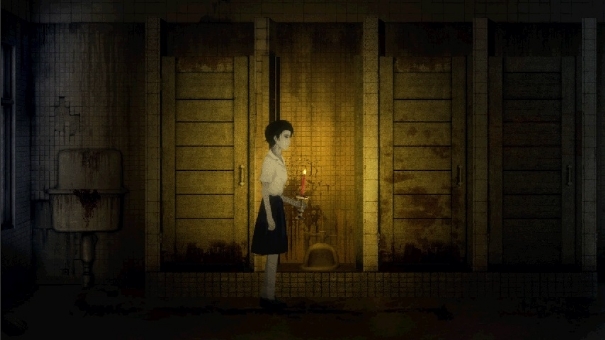“White Terror”
Taiwan was under martial law for thirty-eight years, from 49 to 87. During the White Terror period, about one hundred and forty thousand Taiwanese were imprisoned, and about four thousand of them were executed because they were accused of being opposed to the Kuomintang (Chinese Nationalist Party). Detention is set in the 1960s and blends into the
historical and socio-political context with the influences typical of Asian culture, with references to taoism, Buddhism and the most occult folklore. From the latter come into existence creatures (real or imaginary?) That infest the corridors of an old school, a place transfigured by terrible secrets and supernatural events, within which two students are trapped.
The Detention plot presents two narrative lines that intersect particularly during the second part, telling how oppression and physical and p
sychological violence towards those who refuse submission, struggle for their rights, and is thirsty for knowledge, has been a inhumane custom for many years. Adding to this the personal and family events of the protagonist, branched and perfectly integrated w
ith the game context represented. From this point of view, Detentionit looks like a piece of work overwhelming, which knows very well how to emphasize its strengths, alternating different registers and tones metered to perfection: explicit horror is intertwined by the delicacy of thinking of a young girl, forced to imagine h
is future denied and his adolescence wasted; texts that tell the climate of terror know when to leave room for the vicissitudes of the protagonists and the mysteries that surround the campus; and all in all, the author’s creative effort is evident, which, to give even more concreteness to the tale, have faded from the literature of the time. Detentionis therefore a unique, rare
work, because it is through the potentials of the medium that is able to excel, using the classic canons of graphic adventures to stage an atypical, atmospheric and impact horror survival.
Detention
While embracing the mechanics of a tip and clicking, Detention is not up to it; is rather a two-dimensional adventure that has chosen simplicity of fruition and an essential control system.
The interaction with the scenario takes place via the left mouse button, the areas or objects where the eye icon appears – to analyze specific parts of the sce
nario – and the one that indicates the ability to act. In the latter case, most of the time, you will need to use a harvested object or obtained after the puzzle resolution, drawing it from the inventory (which appears as an overlay when moving the cursor to the bottom of the screen). The right button, on the other hand, allows you to hold back the breath to the character, a fundamental condition not to become prey to the entities that infest the institution and the decadent gaming environments.
Detention can therefore be played comfortably with one hand, with proper med
itations and a good appetite for a horror survival that knows how to diversify from any other such title has emerged in the market, at least for the importance of the issues dealt with. Along the five-hour arc that you will use to know everything about the terrible story, you will find yourself immersed in a context that knows how to alternate dreamlike suggestions, figurative and floating horror blending into the perceptible one of a people in pain, and always very good playing
rhythms. While giving back a bit of backtracking, needed to solve some puzzles and put the items in the right place, Detention can stimulate the player from start to finish. Butit is especially in the second part that gives the best of itself, when the nodes come to the comb, the family affair is further poisoned, the playing environments become mental projec
tions of a deep and inevitable discomfort, and the final leaves you with a poem that speaks of bitterness and violent disenchantment.
“White Terror”
Taiwan was under martial law for thirty-eight years, from 49 to 87. During the White Terror period, about one hundred and forty thousand Taiwanese were imprisoned, and about four thousand of them were executed because they were accused of being opposed to the Kuomintang (Chinese Nationalist Party). Detention is set in the 1960s and blends into the historical a
nd socio-political context with the influences typical of Asian culture, with references to taoism, Buddhism and the most occult folklore. From the latter come into existence creatures (real or imaginary?) That infest the corridors of an old school, a place transfigured by terrible secrets and supernatural events, within which two students are trapped.
The Detention plot presents two narrative lines that intersect particularly during the second part, telling how oppression and physical and psychological violence towards those who refuse submission, struggle for their rights, and is thirsty for knowledge, has been a inhumane custom for many years. Adding to this the personal and family events of the protagonist, branched and perfectly integrated with the game context represented. From this point of view, Detentionit looks like a piece of
work overwhelming, which knows very well how to emphasize its strengths, alternating different registers and tones metered to perfection: explicit horror is intertwined by the delicacy of thinking of a young girl, forced to imagine his future denied and his adolescence w
asted; texts that tell the climate of terror know when to leave room for the vicissitudes of the protagonists and the mysteries that surround the campus; and all in all, the author’s creative effort is evident, which, to give even more concreteness to the tale, have faded from the literature of the time.
Detentionis therefore a unique, rare work, because it is through the potentials of the medium that is able to excel, using the classic canons of graphic adventures to stage an atypical, atmospheric and impact horror survival.
Detention
While embracing the mechanics of a tip and clicking, Detention is not up to it; is rather a two-dimensional adventure that has chosen simplicity of fruition and an essential control system.
The interaction with the scenario takes place via the left mouse button, the areas or objects where the eye icon appears – to analyze specific parts of the scenario – and the one that indicates the ability to act. In the latter case, most of the time, you will need to use a harvested object or ob
tained after the puzzle resolution, drawing it from the inventory (which appears as an overlay when moving the cursor to the bottom of the screen). The right button, on the other hand, allows you to hold back the breath to the character, a fundamental condition not to become prey to the entities that infest the institution and the decadent gaming environments.
Detention can therefore be played comfortably with one hand, with proper meditations and a good appetite for a horror survival that knows how to diversify from any other such title has emerged in the market, at least for the importance of the issues dealt with.
Along the five-hour arc that you will use to know everything about the terrible story, you will find yourself immersed in a context that knows how to alternate dreamlike suggestions, figurative and floating horror blending into the perceptible one of a people in pain, and always very good playing
rhythms. While giving back a bit of backtracking, needed to solve some puzzles and put the items in the right place, Detention can stimulate the player from start to finish. Butit is especially in the second part that gives the best of itself, when the nodes come to the comb, the fam
ily affair is further poisoned, the playing environments become mental projections of a deep and inevitable discomfort, and the final leaves you with a poem that speaks of bitterness and violent disenchantment.


